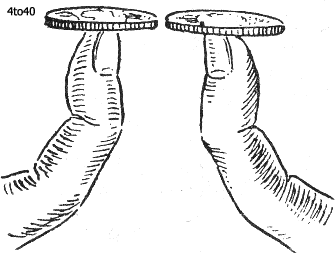
Music of Money
When you jungle coins in your pocket what musical note do they give? This sounds rather like a riddle, but the answer is quite straightforward; see if you can guess the note and see if you are right by striking several notes on a piano. Of course, there is a good deal of confusion about the about the sound, and the confusion is especially marked when the coins are mixed together in a pocket. No sooner has one of them given out its clear note than another touches it and stops the sound, as surely as the sound of a bell is stopped when touched by a finger. Then again, each coin has a note of its own, though there is far less difference than would be expected between a ½ p piece and a I0p piece.
The best coins to experiment with are Iop and 5p pieces. Little coins require more careful handling. All that you need to do is to balance two coins on the tips of the first fingers of each hand, then gently strike the rims of the coins together. They will give out a perfectly clear note like that of a tiny but very musical bell; compare it with notes struck on a piano. When a number of coins are shaken together the notes made by the smallest ones are scarcely heard, so the dominant one of the 50p piece, or Iop piece prevails.
 Kids Portal For Parents India Kids Network
Kids Portal For Parents India Kids Network






